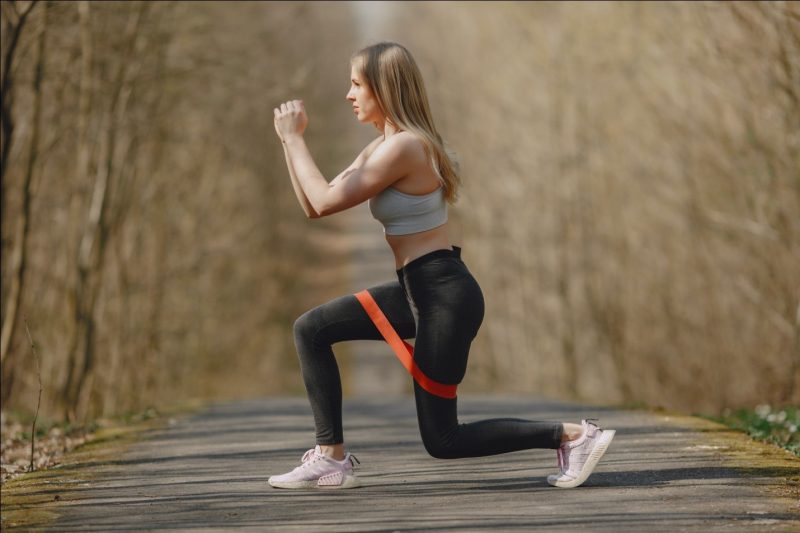It’s no secret that squatting with resistance bands is one of the most convenient and affordable ways to builds strength and muscle. However, while squats are the go-to exercise for the glutes and surrounding muscles, many people don’t find generic squats challenging enough.
Therefore, using resistance bands can give you the challenge you yearn to boost the efficacy of squat exercises. In this guide, we’ll delve into 9 ways to do squats with bands and the perks they usher into your workout routine.
Table of Contents
The Uses and Perks
No products found.
Resistance bands are ideal for squats as they help regulate the squat motions from start to finish. They deliver the much-needed resistance when you lower into a squat, which is known as an eccentric motion, in addition to resistance when you rise to a standing position, which is referred to as a concentric movement (squats with bands).
These movements imply that your muscles are working harder under band tension throughout the exercise, which results in increased muscle mass. The exercise leads to the muscles tearing and breaking down, after which muscle growth and repair signals are sent to the body.
Squats with elastic bands target the hip adductor muscles, glutes, and front thighs (quadriceps). The exercise also targets the secondary muscles such as the core and the back that your body requires for excellent stabilization and balance. The three main types of resistance bands that you can use for a squat exercise are:
1. Loop Bands
- High End Exercise Bands. Our 12"³ By 2"³ Heavy Duty Loop Resistance Bands Come In 5 Varying Resistance Levels. This Makes Them Perfect Whether You Are Just Starting To Workout Or A Seasoned Workout Warrior. Our Extra Light And Light Bands Are Great For Beginners, While Our Medium, Heavy And Extra Heavy Exercise Bands Are Targeted For More Intermediate And Advanced Strength Training.
- Great With Any Workout. This Resistance Band Set Can Be Integrated Seamlessly With Various Popular Workout Program. Or Use Them For General Exercise, Stretching, Strength Training, Power Weight Programs. The Included Carry Bag Makes It Easy To Take Your Bands With You And Do Any Workout Away From Home Or Your Home Gym.
- Multiple Uses. While These Resistance Bands Are Often Used For Sports And Fitness, Physical Therapists Love These Physical Therapy Bands (Rehab Bands) To Help Them Rehabilitate Their Patients. Our Stretch Bands Work For People Suffering From Leg, Knee And Back Injuries. They Are Also Perfect For Use By Women After Pregnancy And Birth To Keep Their Bodies In Shape.
- Superior Quality. All Of Our Exercise Resistance Bands Are Thoroughly Tested Before We Ship Them Out To You. This Ensures Your Bands Are Easy On Skin And Will Provide You With A Worry Free Experience. The Instruction Booklet Includes Dozens Of Different Illustrated Exercises That Demonstrate How To Use Our Resistance Bands For Legs, Arms, Back, Shoulders, Ankles, Hips And Stomach.
- What You Get: Five Exercise Bands With Color-Coded Resistance Levels, Portable Travel Carry Bag And Instruction Guide.
These continuous loops deliver varying levels of resistance. Looped resistance bands are typically worn above the ankles or knees, and their impressive versatility makes them a worthwhile investment for a full-body workout.
2. Mini Loop Bands
No products found.
As shorter loop bands, mini loop bands are designed to be worn above the knees for lower body exercises. They are usually made of a soft fabric that prevents them from rolling up during your workout.
3. Free Bands
No products found.
These are long, thin sheets that you can tie into a loop or wrap around another object or your feet for resistance. Free bands come in handy for lower-body and upper-body exercises.
Resistance bands come in variations of 5lbs to 150lbs loads. It’s crucial to choose a band that delivers the challenging resistance you need while allowing for proper form. Selecting a resistance band that’s overly challenging for you can result in your knees buckling and possibly sustaining a knee injury.
7 Squats with Bands You Can Try
Let’s explore a few banded squat exercises that you can easily incorporate into your fitness journey.
1. Standard Banded Squats
To do the exercise:
- Put a mini loop or loop band slightly above your knees and stand with your feet more than a hip-width apart while ensuring your toes are slightly pointed outwards and your hands are on your hips.
- Slowly thrust your hips back into a sitting position as you bend your knees to a 90-degree angle.
- Maintain the position for up to 3 seconds, then slowly resume to the starting position.
2. Sumo Squats with Bands
To get started:
- Ensure your toes are pointed outwards at a 45-degree angle and stand with your feet more than a hip-width apart.
- Position your mini loop or loop resistance band slightly above the top of your knees.
- Bend your knees into a squat position and thrust your hips back.
- Hold the position for 3 seconds before resuming to the starting position.
3. Banded Goblet Squats
To help activate your core, glute muscles, calves, and quads:
- Ensure your toes are angled relatively outward while positioning your feet fairly more than a hip-width apart.
- Use both hands to grip the ends of the band, then slowly pull them together to the front of your chest, forming a triangle.
- Thrust your butt back while forming a squat position and hold for 3 seconds.
- Push your heels into the ground squeeze your glute muscles while slowly raising your body until you’re standing upright.
4. Banded Pulse Squats
This squat exercise entails:
- Pointing your toes relatively outward, standing with your feet more than a hip-width apart and a mini loop or loop band slightly above your knees, and your hands in front of you.
- Bend your knees and slowly thrust your hips back into a sitting position, forming a 90-degree angle with your thighs parallel to the floor.
- Hold for 5 seconds and rise back up.
5. Banded Lateral Leg Raise Squats
It’s a move that calls for balance and involves:
- Positioning your hands in front of you, standing with your feet more than a hip-width apart, your toes slightly pointed outward, and a loop band slightly above your ankles.
- While focusing on thrusting your hips and bending your knees, form a standard squat position for up to 3 seconds.
- Lift your right leg to the side until you notice the tension of the band before standing upright.
- Repeat the movement with your left leg.
6. Banded Split Squats
To get started with this squat exercise:
- Maintain a hip-width distance between your feet and take a step forward with your right foot.
- Position a loop or free band below your right foot and pull the ends of the band to your sides.
- Similar to a lunge, form a squat position until your knees are at a 90-degree angle.
- While activating your glutes throughout the motion, press down on your right foot to propel yourself into a standing position
7. Anchored Squats
To perform this resistance band exercise:
- Tie a long free band around a firmly shut door, a pole, a knob, or a weighted gym bench, while ensuring it’s up to 4 feet above the ground.
- Position the opposite end of the band above your hips and take a step forward with both feet until you can feel the resistance.
- While thrusting your hips back, bend your knees. You’ll notice the band naturally pulling your pelvis back when your knees are bent.
- Focus on maintaining the proper form without allowing the band to propel you backward.
- Maintain this position for 3 seconds before reverting to standing upright.
Closing Remarks
A resistance band squat is undoubtedly an effective, pocket-friendly, and convenient way to strengthen your glutes and build muscle. These are just a few of the various squats with bands you can perform. By focusing on safe movements and proper form, you can curb injury and get the best outcome.






